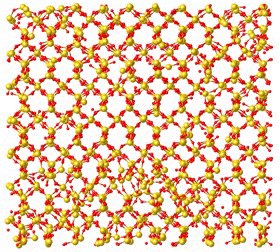May 24 2017
Materials exposed to neutron radiation are likely to experience significant damage, causing containment challenges involved in nuclear plant confinements or immobilizing nuclear waste. These incident neutrons collide with a material’s atoms at the nanoscale, and the atoms, in turn, collide with each other somewhat akin to billiards.
The ensuing disordered atomic network and its physical properties are similar to those found in certain glassy materials, which have led many Researchers to use them in the nuclear research field.
 Snapshot of the atomic structure of a partially irradiated quartz sample. Credit: N.M. Anoop Krishnan/UCLA
Snapshot of the atomic structure of a partially irradiated quartz sample. Credit: N.M. Anoop Krishnan/UCLA
However, according to new results reported this week in The Journal of Chemical Physics, published by AIP Publishing, the similarities between the materials may not be as useful as earlier thought.
The disordered atomic networks of glassy substances are caused by vitrification, the transformation of a substance into glass by melting and rapid subsequent cooling. During the cooling or quenching process, atoms don’t have to settle in an orderly way, and rather form a disordered atomic network. This led a team of Researchers from the Oak Ridge National Laboratory and University of California, Los Angeles (UCLA) to investigate the question: Do irradiation and vitrification have the same effect on the atomic structure of materials?
In order to find an answer, they examined quartz, a simple but ubiquitous material in nature employed for myriad engineering applications.
Since conventional experiments don’t allow investigators to “see” atoms directly, particularly within disordered materials, the team used atomistic simulations with the molecular dynamics technique for their study.
The molecular dynamics technique is based on numerically solving Newton’s laws of motion for a group of interacting atoms. All atoms apply a force on each other that can be used to calculate the acceleration of each atom over time.
Mathieu Bauchy, Assistant Professor, Civil and Environmental Engineering department, UCLA
Using this technique, the Researchers were able to simulate the irradiation-induced disordering of quartz by sequentiallly colliding the atoms of the network with fictitious incident neutrons.
“We also simulated quartz’s vitrification by heating and quickly quenching the atoms,” Bauchy said. “Finally, we compared the resulting atomic structure of these two disordered materials.” Stated Bauchy.
The Researchers discovered surprising differences.
Quite unexpectedly, we found that the disordering induced by irradiation differs in nature from that induced by vitrification. This is quite surprising because glasses and heavily irradiated materials typically exhibit the same density, so that glasses are often used as models to simulate the effect of the exposure to radiations on materials.
Mathieu Bauchy, Assistant Professor, Civil and Environmental Engineering department, UCLA
On the contrary, the results of the study suggest that irradiated materials are more disordered compared to glasses. “The atomic structure of irradiated materials is actually closer to that of a liquid than to that of a glass,” Bauchy said.
The team’s findings potentially have significant implications for the choice of materials for nuclear applications.
“First, we suggest that present models might be underestimating the extent of the damage exhibited by materials subjected to irradiation, which raises obvious safety concerns,” said N.M. Anoop Krishnan, a postdoctoral researcher also at UCLA. “Second, the different natures of irradiation- and vitrification-induced disordering suggest that glasses can also be affected by irradiation.”
This is an important discovery because glasses, which are considered to “self-heal” under irradiation, are generally used to immobilize nuclear waste through vitrification.
These waste forms are expected to remain stable for millions of years once deposited into geological depositories, so our lack of understanding of the effect of irradiation represents a real concern.
N.M. Anoop Krishnan, Postdoctoral Researcher, UCLA
Next, the team plans to study the impact of irradiation on common aggregates found on the nuclear waste immobilization glasses and in the concrete of nuclear power plants. “Ultimately, our goal is to develop novel models to predict the long-term effect of irradiation on the structure and properties of materials,” Bauchy said.
Irradiation- vs. vitrification-induced disordering of quartz
Video illustrating the type of atomic disordering observed upon irradiation and vitrification. Credit: Jonathan Berjikian and N.M. Anoop Krishnan/UCLA.